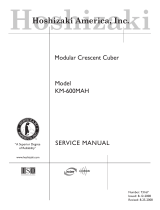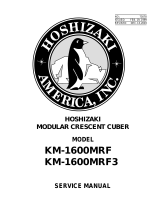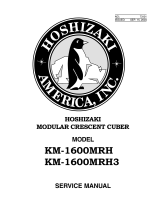
20
e) Initial Harvest Cycle Termination Diagnosis: When the thermistor reaches 48°F
(9°C), CB reads 3.9 kΩ from the thermistor and turns harvest termination over to
the harvest timer (S4 dip switch 1 & 2). Check discharge line temperature. For a
thermistor check, see "II.F.Thermistor Check." If 1-min. ll cycle starts after harvest
timer terminates, check that FS is clean and operating properly, see "II.E. Float
Switch Check and Cleaning." If FS is closed, CB proceeds to the next cycle. Ifnot,
replace CB.
Note: The minimum total time allowed by CB for a complete harvest cycle is 2 min.
Maximum harvest time allowed is 20 min.
NOTICE! On models with "G" control board and no harvest pump timer relays,
S4dip switch 7 must remain off. Otherwise, PM energizes in reverse direction the
last 50 seconds of harvest and empties water from water tank.
6) Freeze Cycle – LED 1 is on. Comp and FMR continue. PM, FM, and LLVenergize.
WV and HGV de-energize. Appliance is held in freeze by a 5-min. short cycle protection
timer. After 5-min. timer terminates and FSopens, freeze cycle terminates.
a) Freeze Cycle Diagnosis: Conrm Comp and FMR continue. Conrm that
PM, FM, and LLV energize. Conrm WRV opens. Next, conrm WV and HGV
de-energize. During the rst 5 min. of freeze, conrm evaporator is cooling. If not,
conrm WV de-energized (not leaking by), HGV de-energized (not bypassing),
LLV and FM energize, TXV and HM operate correctly, WRV opens, Comp is
efficient, and refrigerant charge is correct. See "VIII.A. Specication Sheet" and
"VIII.B.Performance Data."
b) Comp and FMR Diagnosis: If Comp and FMR de-energize once freeze begins,
check that appliance has not shut off on HPS ("POWER OK" LED off). If so, check
"3)b) HPS Diagnosis" above. If "POWER OK" LED is on, check for 115VAC at CB
K1#1 (V) or #9 (V) to neutral (W). If 115VAC is not present and LED 1 is on, replace
CB. If 115VAC is present, check for 115VAC at CR or MC coil. If 115VAC is present,
check CR or MC coil and contact continuity. Replace as needed. If CR or MC is ok,
check Comp external overload, start relay, and start and run capacitors. Next, check
Comp motor winding continuity. If Comp is energized but evaporator is not cooling,
check for an inefficient Comp. See "VIII.B. Performance Data." If Comp is energized
but FMR is not, check for 115VAC at the FMR junction box. If 115VAC is not present,
check icemaker wiring connections. If 115VAC is present, check for voltage at
condenser unit. If115VAC is not present, check eld wiring connections. If 115VAC is
present, check FMR capacitor, motor winding, and fan blade for binding.
c) WV and HGV Diagnosis: If WV is energized, check for 115VAC at CB K1 #6 (O) to
neutral (W). If 115VAC is present after PM energizes, replace CB. If 115VAC is not
present, replace WV (bypassing). If HGV did not de-energize, check for 115VAC at
CB K1 #2 (P) to neutral (W). If 115VAC is present after PM energizes, replace CB.
If115VAC is not present, replace HGV (bypassing).


























